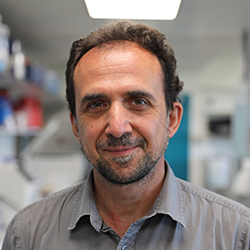- Research Group Leader, Early Cancer Institute
- Co-Lead, CRUK Cambridge Centre Thoracic Cancer Programme
Biography
Daniel studied Biology and Molecular Biology at the Autonomous University of Madrid in Spain, where he also completed his PhD with cum laude honours within the Viral DNA Replication Group at the Centre of Molecular Biology Severo Ochoa (CMBSO), under the supervision of Dr Margarita Salas. During his PhD he also worked at Sir William Dunn School of Pathology (University of Oxford, UK) as a visiting student. He was then awarded an I3P Fellowship followed by a Spanish National Research Council Fellowship to conduct postdoctoral research on DNA replication, resulting in several first- and/or corresponding authored papers (including 5 PNAS, The EMBO Journal and 3 Journal of Biological Chemistry). Based on his research, a patent was filed on a novel gene delivery system to Sygnis AG Pharma (2013). He then moved to the Spanish National Cancer Research Centre (CNIO) to Dr Manuel Serrano’s group, where his main work, published in Cell and Nature Reviews Molecular Cell Biology, culminated with two awarded grants: a “Ramon y Cajal Programme Senior Grant” and a “National Programme Grant for Researched Aimed at the H2020 Societal Changes”.
In 2016, Dr Muñoz-Espín joined the Department of Oncology at the University of Cambridge as a Senior Research Associate and Principal Investigator as part of the Early Detection Programme of the Cancer Research UK Cambridge Centre. Some of his current funding sources include an MRC New Investigator Research Grant, a Royal Society Research Grant, a CRUK-OHSU Early Detection Grant, and a CRUK Programme Foundation Award. The experimental outputs of Muñoz-Espín´s lab have been published in EMBO Molecular Medicine and Aging Cell, among other peer-reviewed journals.
Lung cancer is the most common cause of cancer-related deaths worldwide. Out of the 8 million of the cancer-associated deceases taking place every year the estimates put over 1.6 of them as directly assigned to lung cancer. Although the efforts devoted to lung cancer research over the last decades have been formidable the underlying processes and mechanisms promoting lung cancer initiation, progression and resistance remain largely unknown. Consequently, the available tools to achieve lung cancer early diagnosis, as well as the therapeutic approaches, are not good enough to tackle this disease, being lung cancer progression and relapse inevitable in many cases. Unfortunately, most of the cases are diagnosed at advanced stages and ~90% of the patients die within a 5-year window from the first diagnosis.
Our group works at interface between lung cancer and the tumour microenvironment. We are interested in cellular states such as cellular senescence, plasticity and the fundamental processes and mechanisms that lie at the origin of cancer. We are also developing novel tools and nanodevices for cancer therapy and diagnosis.
Key areas of interest:
- CRUK Cambridge Centre research programme(s): Early Detection Programme, Thoracic Cancer Programme
- Tumour type/site: Lung Cancer
- Methods & technologies:
- In vitro cancer models (2D and 3D)
- In vivo lung cancer models (xenografts, orthotopic, GEMs, PDTXs)
- Human tissues and patient samples
Publications list:
Google Scholar: https://scholar.google.co.uk/citations?user=JyPn_SkAAAAJ&hl=en
PubMed: https://pubmed.ncbi.nlm.nih.gov/?term=munoz-espin%20d&sort=date
Key publications:
- Activatable senoprobes and senolytics: Novel strategies to detect and target senescent cells. Morsli S, Doherty GJ, Muñoz-Espín D. Mech Ageing Dev. 2022 Mar;202:111618. doi: 10.1016/j.mad.2021.111618.
- Cellular senescence in cancer: from mechanisms to detection. Ou HL, Hoffmann R, González-López C, Doherty GJ, Korkola JE, Muñoz-Espín D. Mol Oncol. 2021 Oct;15(10):2634-2671. doi: 10.1002/1878-0261.12807.
- Galacto-conjugation of Navitoclax as an efficient strategy to increase senolytic specificity and reduce platelet toxicity. González-Gualda E, Pàez-Ribes M, Lozano-Torres B, Macias D, Wilson JR 3rd, González-López C, Ou HL, Mirón-Barroso S, Zhang Z, Lérida-Viso A, Blandez JF, Bernardos A, Sancenón F, Rovira M, Fruk L, Martins CP, Serrano M, Doherty GJ, Martínez-Máñez R, Muñoz-Espín D. Aging Cell. 2020 Apr;19(4):e13142. doi: 10.1111/acel.13142.
- Targeting senescent cells in translational medicine. Paez-Ribes M, González-Gualda E, Doherty GJ, Muñoz-Espín D. EMBO Mol Med. 2019 Dec;11(12):e10234. doi: 10.15252/emmm.20181023
- A versatile drug delivery system targeting senescent cells. Muñoz-Espín D, Rovira M, Galiana I, Giménez C, Lozano-Torres B, Paez-Ribes M, Llanos S, Chaib S, Muñoz-Martín M, Ucero AC, Garaulet G, Mulero F, Dann SG, VanArsdale T, Shields DJ, Bernardos A, Murguía JR, Martínez-Máñez R, Serrano M. EMBO Mol Med. 2018 Sep;10(9):e9355. doi: 10.15252/emmm.201809355.
- Cellular senescence: from physiology to pathology. Muñoz-Espín D, Serrano M. Nat Rev Mol Cell Biol. 2014 Jul;15(7):482-96. doi: 10.1038/nrm3823.PMID: 24954210
- Programmed cell senescence during mammalian embryonic development. Muñoz-Espín D, Cañamero M, Maraver A, Gómez-López G, Contreras J, Murillo-Cuesta S, Rodríguez-Baeza A, Varela-Nieto I, Ruberte J, Collado M, Serrano M. Cell. 2013 Nov 21;155(5):1104-18. doi: 10.1016/j.cell.2013.10.019.

